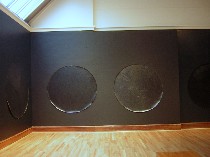
How it came to be that I like Quentin Morris yet abhor Robert Ryman and remain undecided about Ad Reinhart is one of the mysteries of my convoluted mind–and then again, maybe not (right, Morris’ “Untitled (November 2004)” and “Untitled (September 2004)”).
Morris and Reinhart both create all black paintings, and for Morris it’s a 24-7 blackout career (for Reinhart, a 24-7 blackout reputation, but he does other paintings and art as well). Robert Ryman creates only supposedly all-white paintings, but he waffles, interrupting the white with color and prominent hanging systems and his name. More on the comparisons later.
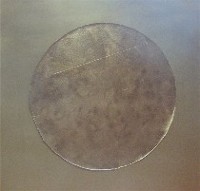 Morris is in all his glory right now in a solo show/installation at the Morris Gallery at the Pennsylvania Academy of Fine Arts. The installation brings to my mind a prayer space, the Mayan observatory atop Chichen Itza and a calendar based on maps of the moon (left, “Untitled (January 2004)”).
Morris is in all his glory right now in a solo show/installation at the Morris Gallery at the Pennsylvania Academy of Fine Arts. The installation brings to my mind a prayer space, the Mayan observatory atop Chichen Itza and a calendar based on maps of the moon (left, “Untitled (January 2004)”).Morris, a local artist whose work is an evergreen presence (everblack? Everlast?) at the Arcadia Works on Paper show, has found more ways to create black-out art than any other artist ever, I’d wager, because he’s been at it 40 years with a monastic constancy that suggests he’s thinking about more than just pigment.
And just in case you made the mistake of thinking he’s an all pigment-and-materials all the time guy, this show is a firm reminder that he’s going in lots of directions at once as he drives straight ahead into midnight.
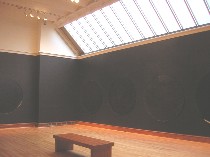 So beneath the flooding light of the clerestory windows in the Morris Gallery, on all-black walls (a surely comic relief from all white ones), Morris has hung 13 black canvas circles, their rough, stringy edges cupping to create giant platters that catch the light at the edges differently from the way the flat centers do. Each circle, painted with silkscreen ink and polymer acrylic (except for the one that’s spray painted), looks different–some cloudy, some pock-marked and geographical, some blacker, one almost gunmetal gray–and taken together the variations serve as a commentary on the blindness in that old joke of what white folks used to say about black folks and black folks about white folks–They all look alike to me (installation view at Morris Gallery).
So beneath the flooding light of the clerestory windows in the Morris Gallery, on all-black walls (a surely comic relief from all white ones), Morris has hung 13 black canvas circles, their rough, stringy edges cupping to create giant platters that catch the light at the edges differently from the way the flat centers do. Each circle, painted with silkscreen ink and polymer acrylic (except for the one that’s spray painted), looks different–some cloudy, some pock-marked and geographical, some blacker, one almost gunmetal gray–and taken together the variations serve as a commentary on the blindness in that old joke of what white folks used to say about black folks and black folks about white folks–They all look alike to me (installation view at Morris Gallery).Morris is African American and race is one of the many issues embedded in this art. Morris is also a PAFA alum, and it’s back when he was a student that his obsession with black became his quest.
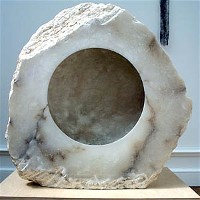 The meditative elegance of the installation say Zen. Turns out Morris is a practicing Buddhist.
The meditative elegance of the installation say Zen. Turns out Morris is a practicing Buddhist.In art terms, I’m reminded of Anish Kapoor‘s Extreme Pigment-colored cavities in rocks that practically vibrate with the mystery of whether they are holes or pretend holes or the presence of some higher form (Kapoor’s “Untitled,” left).
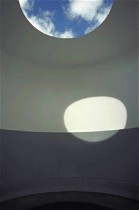
I’m also reminded of James Turrell and his light and astronomy games that also raise depth and divinity issues, as well as cosmology (right, Turrell’s “Kielder Skyspace”).
But Morris is working in the opposite direction, turning what people expect as nothing, as a black hole, into a something. Interestingly enough, this too suggests cosmic expansiveness and spirit. (I just want to add that it’s almost unfair to cavil with artists thinking of black as a negative, because when black competes with colors in a painting, it tends to recede, losing its detail and its surface material presence.
By eliminating the colors, however, Morris keeps your eye on the surface, where he has managed to make a lot happen. He also keeps your eye on the fabric or paper or whatever support.
Part of what I find interesting in this installation, however, has to do with minimalism. Morris is using a minimalist strategy of circling the rooms with equal-sized circles, 72″ in diameter, but he’s subverting the minimalist multiplicity with variety and detail that defy any notion of mass production.
And here’s where I have to contrast him to Ad Reinhart, who is a minimalist, taking the particularity out of each point in the painting and reducing it to what looks like a black-on-black industrial grid. Reinhart is closer to Pop, closer to reproducibility, and nowhere in the realm of Godhead. The two artists interesect at color choice and at materiality, but Reinhart’s materiality is controlled and commanded, whereas Morris’s materiality is humanist and filled with idiosyncracy and gesture.
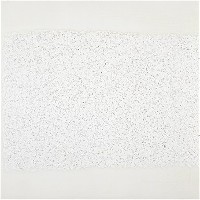 As for Robert Ryman, who Roberta and I once decided bought his lifetime supply of paint at a really big White Sale at Pearl Paint, he’s not a minimalist and he’s not about spirit and he’s not about race. He’s about himself and his material (witness the size of his name on some of his paintings–in some cases the only relief from whiteness). Thin (left, Ryman’s “Case”).
As for Robert Ryman, who Roberta and I once decided bought his lifetime supply of paint at a really big White Sale at Pearl Paint, he’s not a minimalist and he’s not about spirit and he’s not about race. He’s about himself and his material (witness the size of his name on some of his paintings–in some cases the only relief from whiteness). Thin (left, Ryman’s “Case”).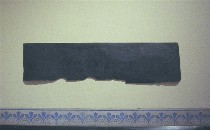
In addition to the 13 paintings in the installation, the outside hall has four spray paint-on-paper pieces with chewed up edges that speak of wearing away. Some of them have lint and dust. Like the circles, some have creases, scars and bits of whatever beneath the paint surface (right, Morris’ “Untitled (September 1992)”).
While I couldn’t personally ever make such a choice in a world of glorious colors, Quentin Morris has done it convincingly–more convincingly than the two art big-boys whose monochromatic canvases are icons in the modernist play book.
The show, which is up until Feb. 11, is accompanied by an excellent essay by Gerard Brown. He blathers on even more than I did.
Also, Larry Becker Gallery, which contributed to the PAFA show, has some Quentin Morrises in a group show that runs to Jan. 22.









